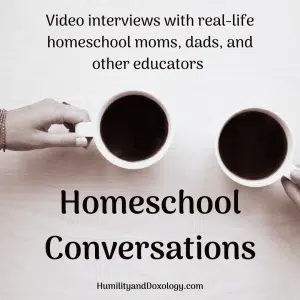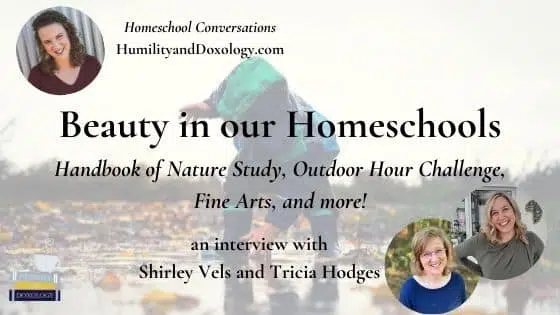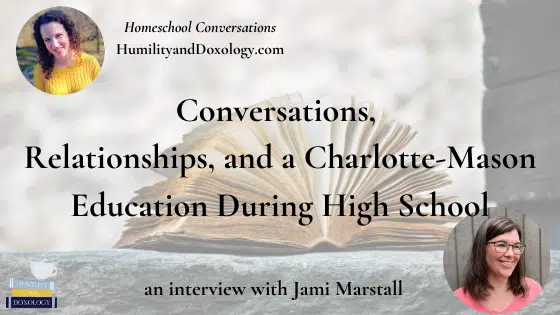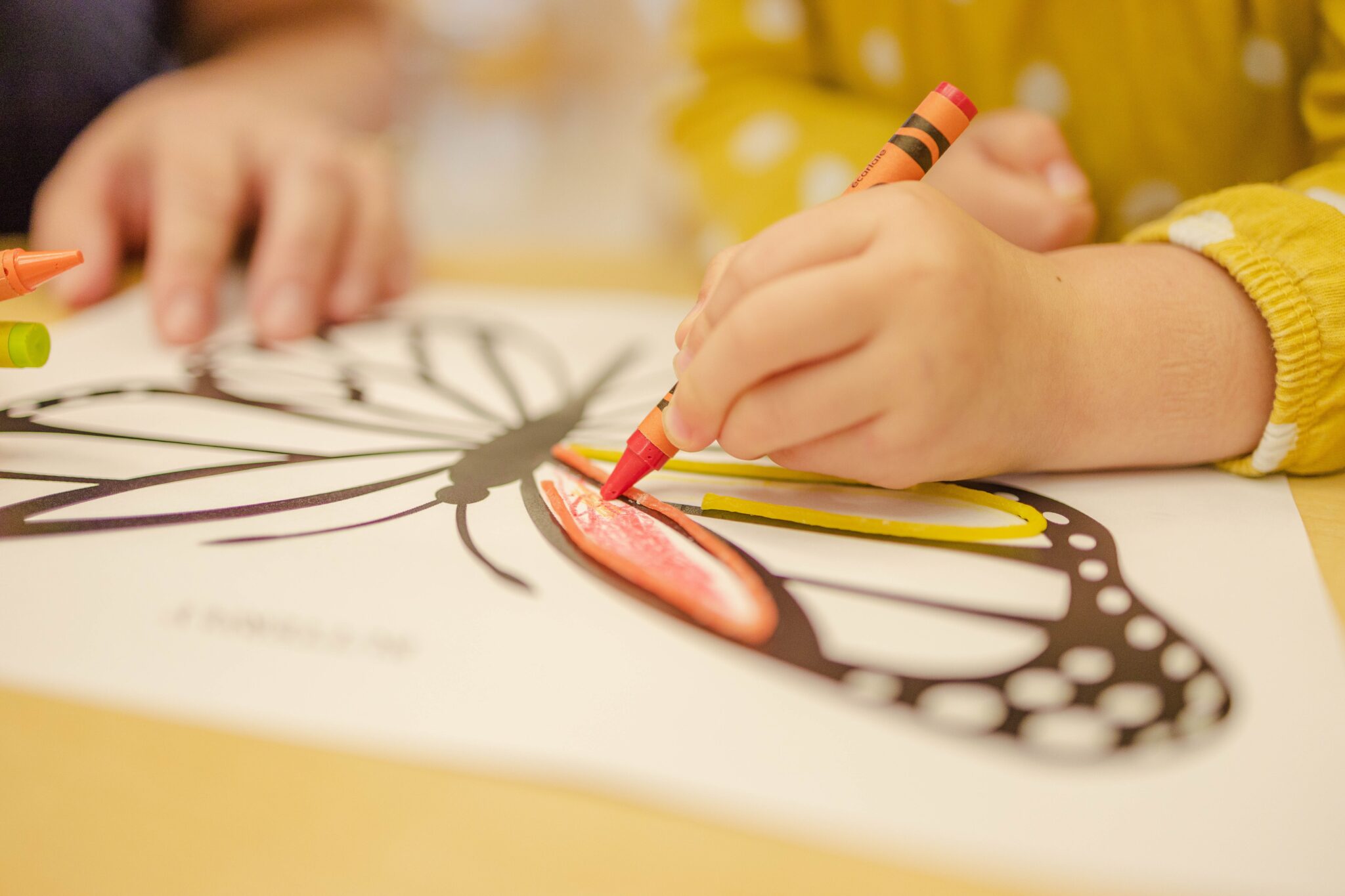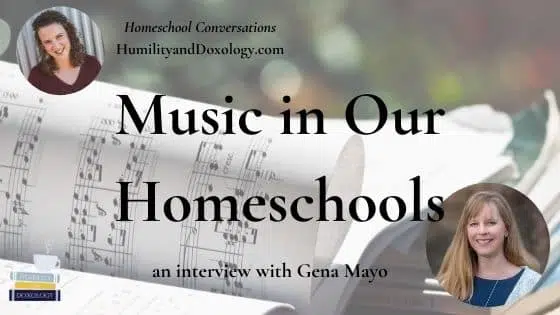As homeschool moms we can often get into a “get it done and check the boxes” mode. We have so many responsibilities and pulls on our time, and it’s way to easy to give up on beauty in our homeschools. Prioritizing all those extra beautiful things just feels too overwhelming. But is it important and valuable to prioritize these elements of beauty in our homeschool? Might, in fact, those elements of beauty (like nature study and fine arts) actually be one of the most important relational elements in our home education?
Today’s guests answer with a resounding YES! Tricia Hodges is a returning guest to the podcast, and she is joined today by her friend (and colleague at Nature Study Homeschool) Shirley Vels. Both veteran mamas with homeschool graduates, Shirley and Tricia have an important long-term perspective to share with us today. Plus, I learn that The Handbook of Nature Study isn’t as intimidating as I thought it was!
Be sure to check out all the other interviews in our Homeschool Conversations series!
Watch the video. Listen to the podcast. Read the show notes. Share with your friends!

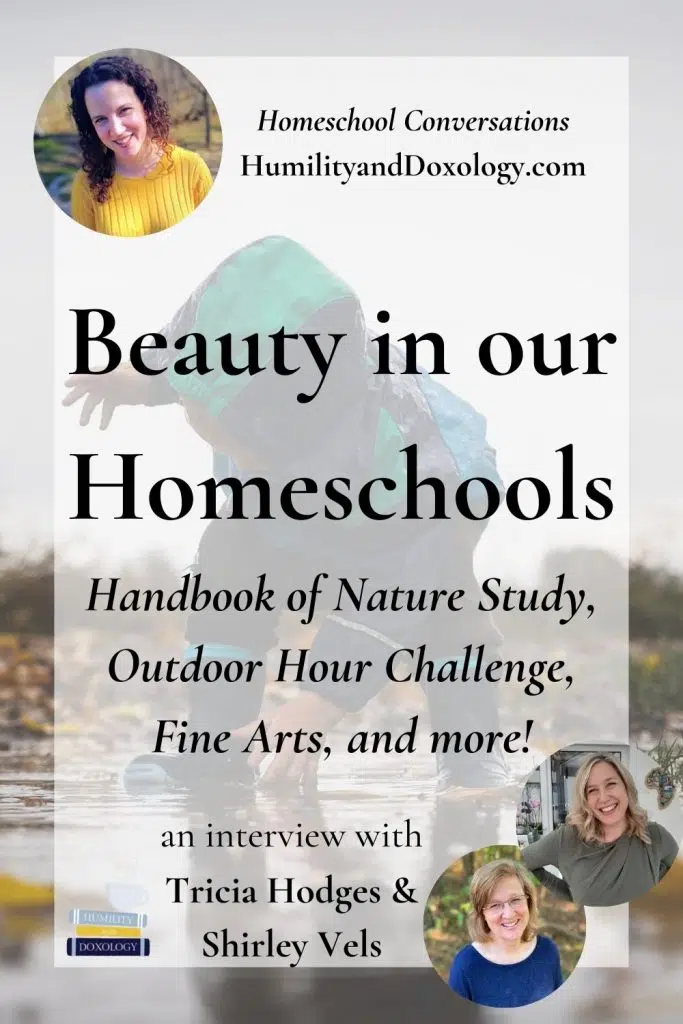
{This post contains paid links. Please see disclaimer.}
Who are Tricia Hodges and Shirley Ann Vels
Homeschooling since 2000, Tricia has seen the fruits of home education with five children (three homeschool grads so far!) She began blogging at Hodgepodgemom in 2008, sharing helpful homeschool habits, recipes and her mother’s art lessons. With their You ARE an Artist curriculum, Tricia, “Nana” and her family are passionate about helping others grow a love of art. She also shares reviews of her family’s favorite curricula at The Curriculum Choice and is the author of the book, Help! I’m Homeschooling! Tricia lives in Georgia with her husband, Steve, and the Hodgepodge.
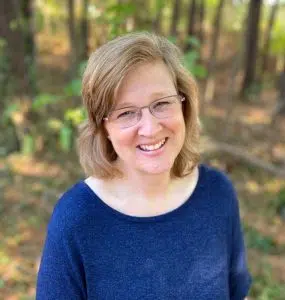
Shirley lives in Chester, England and blogs at Building A Household of Faith where she writes about homeschooling the Charlotte Mason way, nature study and encouraging homeschooling moms in their great charter as Christian wives, mothers and keepers of the home. She also hand-dyes yarn in her home studio Under An English Sky, which is inspired by the English countryside and of the great living books she and her family enjoyed over their homeschooling journey. No doubt you will be sure to recognise some of the names of her yarn from literary childhood favourites!

Watch my interview with Tricia and Shirley from Nature Study Homeschool
Prefer to listen to your content? Subscribe to Homeschool Conversations on Apple podcasts or wherever you get your podcasts so you don’t miss a single episode!
Amy: Hello everyone. Today I am joined by Tricia Hodges and Shirley Vels.
Homeschooling since 2000, Tricia has seen the fruits of home education with five children, three homeschool grads so far, congratulations for that. She began blogging at Hodgepodge Mom in 2008, sharing helpful homeschool habits, recipes, and her mother’s art lessons. With their You ARE an Artist curriculum, Tricia “Nana” and her family are passionate about helping others grow a love of art. She also shares reviews of her family’s favorite curricula at the curriculum choice and is the author of the book Help I’m homeschooling. Tricia lives in Georgia with her husband, Steve, and the hodgepodge.
Shirley lives in Chester, England, and blogs at building a household of faith where she writes about homeschooling the Charlotte Mason way, nature steady, and encouraging homeschooling moms in their great charter as Christian wives, mothers, and keepers of the home. She also hand-dyes yarn in her home studio Under an English Sky, which is inspired by the English countryside and the great living books she and her family enjoyed over their homeschooling journey.
I know my teenage daughter would be so fascinated to talk to you about that which is not the topic of today’s conversation, but I want to ask you all sorts of questions about that.
Let’s start by you guys telling us a little bit about yourselves and your families and how you began homeschooling. Tricia, how about if you start us off with that.
Tricia: Okay, well, how we began homeschooling was my daughter, we had her go to our church preschool, which was a fantastic and wonderful program, but it just absolutely broke my heart to take her. It helped me to realize that she was already learning so much at home, and it helped me to take that step to do homeschooling. Plus, the Lord had just surrounded us with some wonderful homeschool families.
Amy: How about you Shirley, how did your family begin homeschooling?
Shirley: Well, very much like Tricia, I think it broke my heart every morning to drop my daughter off at preschool. She would be crying at the gate, and I just thought there has to be a better way than this, this cannot be right, it just didn’t sit well with me.
Then my husband was transferred to run a hotel in Barbados and we sent out our two daughters to school. I remember, it was an international school where ex-pats took their children, and it was an all-day affair and it was really hot. I remember going to fetch them one afternoon, and my youngest daughter, who was two and a half at the time, because they started really young.
They were running around the field in this heat. I just thought, “What am I doing? This is just not right.” At that point, I didn’t have any other homeschooling families around me but I just felt the Lord saying you need to bring them home. After chatting with my husband, who was initially quite against it, the Lord worked in my husband’s heart, and a year or so later, he said, “Let’s bring them home and homeschool them.” That’s what we’ve done all the way through.
Amy: I love hearing how similar in some ways your two experiences were where you started in a way that like, “Okay, well this is just what we do. We send the kids to the preschool and we follow this pattern.” But there was something that just wasn’t quite right so you jumped into this homeschooling thing.
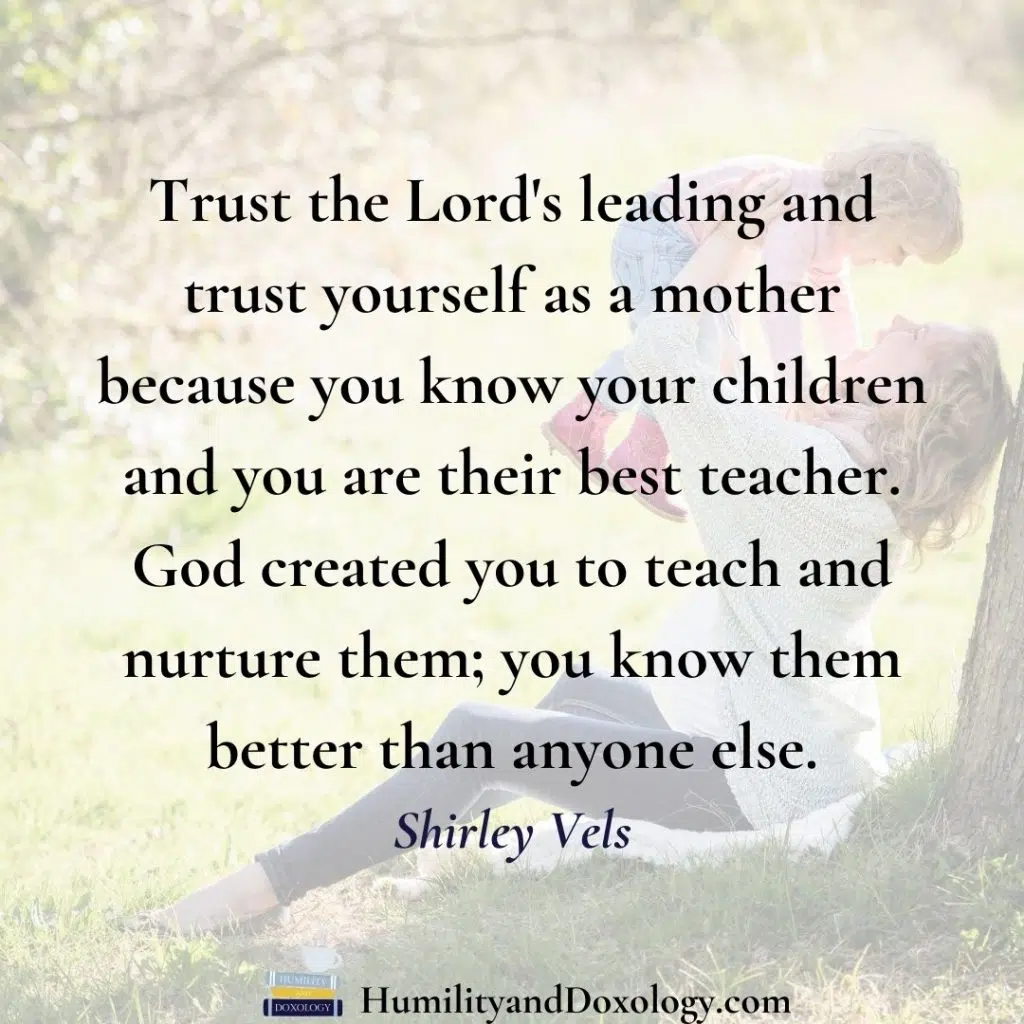
Growing and Changing In Homeschooling Perspective
Then over the years, one of my favorite questions to ask people, especially people who’ve been homeschooling for a long time, like you guys, is how did you see your approach to homeschooling, or your thoughts about homeschooling grow or change over those years? Shirley, how about if you start and answer that question first.
Shirley: I think because we were called by the Lord to educate our children at home, I felt very strongly that we needed to follow his leading and he led us to, first of all, put Him first and foremost in our home schools, and it was Kingdom children that I was raising, they were his children. We needed to trust and follow his leading and he brought about Charlotte Mason way of homeschooling, which just resonated with my heart and we followed through that.
I found it really difficult once we reached high school years, because the pressure to conform, and to follow the usual route was immense and had me questioning and doubting myself for a good many years until I managed to have a conversation with Tricia in my panic, and because she had gone on before me, she was able to say, “You know what? Don’t worry, this is what you need to do.”
I think living in the UK, and taking such a vastly different route to the other homeschoolers in this country, we were really breaking ground, but I felt strongly that the Lord was saying you need to continue teaching your children in this way and the way that they should go, and so we did. Amazingly, I say that because I’m just at floored every single day that what shouldn’t have happened has happened. My children have graduated our homeschool and finishing their final year at universities and with their various courses and just in my mind, that shouldn’t have happened because they didn’t follow the traditional route but God opened doors.
I think, looking back, if I could give any wisdom and advice is trust the Lord’s leading and trust yourself as a mother because you know your children, and you are their best teacher. God created you to teach and nurture them, you know them better than anyone else. That I think is my biggest overriding thing is don’t doubt yourself so much.
Amy: What an important encouragement, so often, I think, especially when we hit those high school years, we’ve been doing maybe something a little outside the box, or pursuing a Charlotte Mason education or whatever unique family path we’ve chosen, and then we hit high school, and it’s like, “Oh, no, we have to go back and do things just the way everybody else is doing.” It’s like something flips a switch, and we freak out again, all over again. It’s so encouraging to hear from moms like you who have gone through those high school years, and continued to pursue this unique path.
I’ll just make a note. If anyone’s listening, I encourage you to go back and listen to my chat with Jami Marstall, who talked all about how Charlotte Mason education can and ought to be continued in the high school years, that you don’t have to stop just because your kids are teens.
How about you, Tricia, how did things grow and develop, or are they growing and your homeschool?
Tricia: I’m not sure that I can add much to what Shirley said, because she pretty much answered it just the way that I would. The only thing I would add is that I am a rule follower by nature so it took me a while to actually step into the freedoms of homeschooling, but once I discovered that, once the Lord opened the door for those different types of freedoms, then my children also were able to learn in the ways that the Lord designed them and that has brought such joy. Just to have that recognition that you have the freedom to do what He is leading you to do. Just like Shirley said, you don’t have to do it like this family or because that is what the world is telling you to do.
Including Beauty in Our Homeschool
Amy: I feel like we could just pause here and just think about these things for a little while but I do want to get to one of our main topics of conversation today, which is this idea about including beauty in our homeschool. I don’t know about you guys, but I know for myself and other homeschool moms, we can just get into this, get it done, check off the boxes, we’ve got our to-do lists, there’s more things that we can even possibly get to and we just get our head down and keep going through. We have multiple kids or we’re working inside the home or outside the home while homeschooling and it can just feel like one more thing, right?
Like, “Okay, I don’t know if we’re really going to prioritize all those extra beautiful things because it just feels overwhelming.” Maybe that attitude and perspective is not so great, so why would you say it’s important and valuable to prioritize these elements of beauty in our homeschool? How can we shift our mindset so it’s not like one more burden on our back? Tricia, what would you say about that?
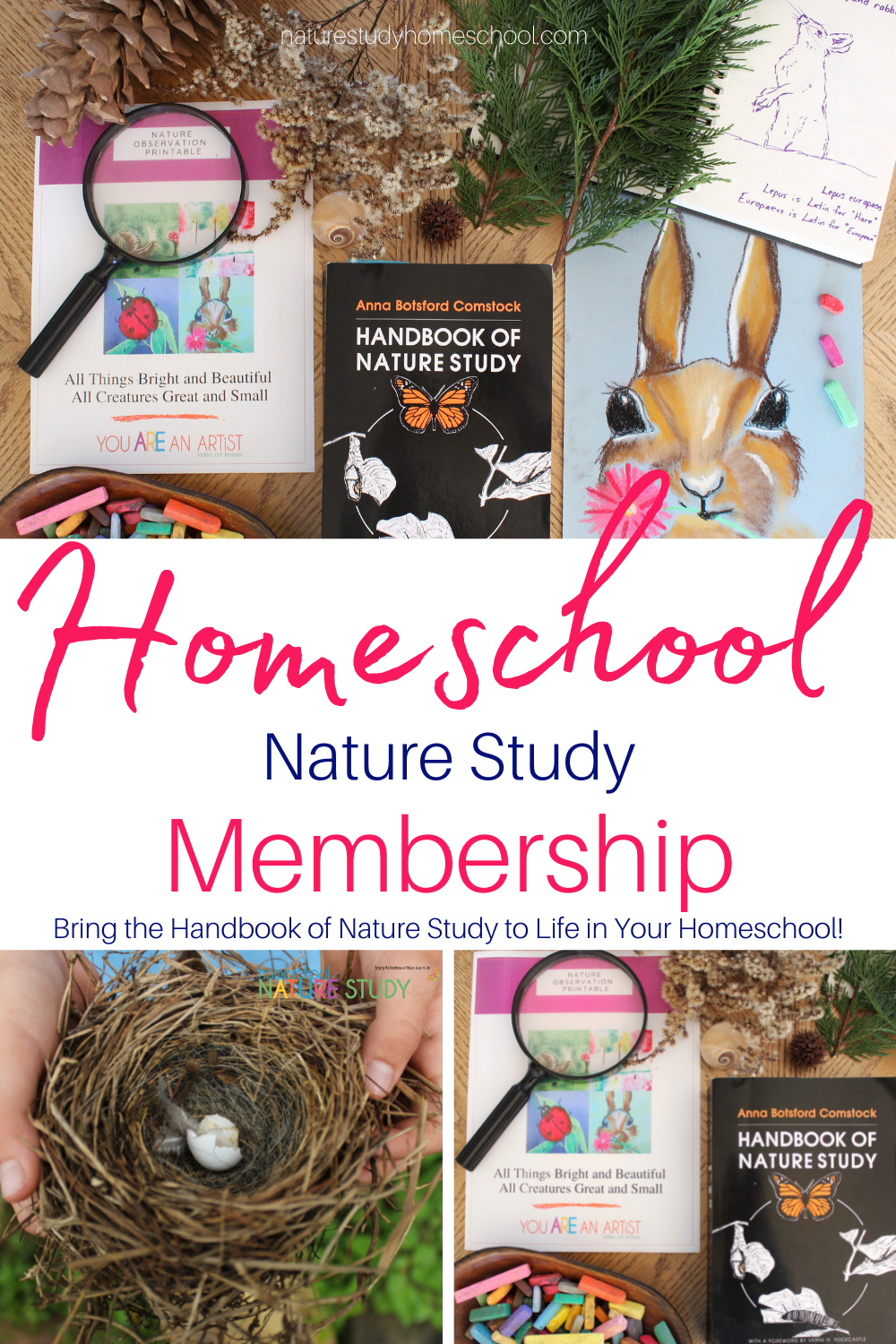
Tricia: Well, that goes back to me being a rule follower and finding those freedoms. Your children can have fun, and you can have fun with your children, and it can be so very simple. If you were to fling open the door and go enjoy learning something outside, don’t you as a child remember those special times when you were lifted up out of your normal atmosphere and placed in a different setting. You remember those senses and the things that you actually saw and heard. It just adds such a new level of learning that if you just stay in one spot and check off the boxes, then you miss so much. It’s truly that joy, building memories together.
I remember all those different things that my grandmother would teach me when we would walk through a path or along the creek, much more than that math test that I had struggled over when I was younger. [chuckles]
Amy: How about you, Shirley?
Shirley: I would absolutely agree. I think that when you knock off those beautiful things off the to-do list because the tick box is just yelling and screaming in your face, you’re excluding something that creates memories in your children. Like Tricia said, it is not the math lesson or the English lesson that my children remember when they say to me, “Mom, thanks for an amazing homeschooling time. Thank you for that childhood, because you gave us a childhood that I will remember for always.” Now that, they take up with them into adulthood and it’s those precise things that you gave them that grounding in their childhood that they draw on when life becomes really tough and life does become tough.
They’re not drawing on, “Well, I learned my timetables by the time I was six years old.” They are drawing on the times and the conversations and the bonding that you had when you were on your nature walk, out in nature. They are drawing on the times when you had your tea parties and enjoyed poetry together. A child was so much more than just a tick box. So much more than just a maths lesson. You’re nurturing the soul of a child, and that’s what you want them to take with them into adulthood because they do not stay young forever.
They grow up, they become adults, they have adult problems to face. If they don’t have that rich culture, that family culture to draw upon, they can get lost. I would not change a single thing. We continued with our nature studies and our poetry and our artists’ appreciation right the way through high school when it can be pressured to, like I said, give over those things for the more academic subjects. These beautiful things are no less valuable than those academic subjects. Be careful before you say, “Well, we don’t have time for that today,” because you could be giving a memory there, not creating a memory. Those things strengthen our bonds and they strengthen us as people.
Amy: I think that’s so important and well said. I’m a second-generation homeschooler actually. When I think back on my own homeschool experience, I certainly remember the wonderful academics that were taught to me. My favorite memories are a lot of those special times that we had together. You brought up the word relationship, both of you guys. It’s really more about this bond and those memories that you’re creating sometimes even than it is the specific thing you’re doing together. Sometimes it’s not even planned things.
I remember one time going out for a walk in the neighborhood. We were just in a regular suburban neighborhood. We were walking and we saw this spider that was spinning a web right there at eye level. I just remember my parents being like, “Hey, let’s just sit here and watch it.” My dad, and my brother, and I ended up just staying there for, I don’t know, in my memory, it was like an hour or two hours. I don’t know if it was really that long.
I just remember watching it for so long as the sun set and just changing our whole plan for the evening. I’ll never forget that memory that moment. Sometimes it’s just taking the opportunity when it presents itself too. Not being like, “Oh, we don’t have time to stop and look at the spider. We’ve got to stay on our schedule.”

How to Use the Handbook of Nature Study in Our Homeschools
Well, let me ask you specifically about Handbook of Nature Study, which I know, Shirley, you are, what do you call it? The hostess? Are you the hostess for that?
Shirley: Yes.
Amy: Okay. This book is a little intimidating to me. I actually have on my shelf the copy that my mom had on our shelf growing up, which I just also remember being like, we would pop into it to look something up. Much as I have used it as a reference a few times with my own children. Mainly, it just seems so vague and I’m not really sure what I’m supposed to do with it. It seems like it’s just for fancy Charlotte Mason people. I would love to just hear a little bit about like, “What is this book?” How does just a normal ordinary family approach it?
Shirley: To start with, on our homeschool nature study website, we have a great start here tab, which gives quite a few posts on how to use Handbook of Nature Study. I think when you’re faced with such a huge volume, this is your nature study curriculum, it can absolutely be daunting.
I think it’s important to remember that A, it’s not a field guide. You do not need to be hauling this about with you on your nature studies. B, it was actually a collection of leaflets written to elementary school teachers who didn’t know anything about plants and less about the earth beneath them and the skies above them. It was really written as a guide to help people who didn’t know much about nature teach their students. That’s us, isn’t it?
As we start off, we have this idea of wanting to spend time teaching our children about nature, but where do we start? We don’t know anything. I think the one thing I have learned is that that’s okay, you don’t need to. You can learn alongside your children little by little. That’s what Handbook of Nature study helps us with. It is a collection of written by naturalists of information on our natural world topic by topic. It gives you lessons where it gives you suggestions on things that you can do in order to explore.
A lot of our learning is through observation. When you are out in nature observing, and when you become attuned to those beautiful little things that you were speaking about earlier, you become aware of the world around you and nature’s natural rhythms. The Handbook of Nature study is for the teacher, not for the child. It is for you to get that information. It’s not that daunting when you are taking it in little chunks, theme by theme.
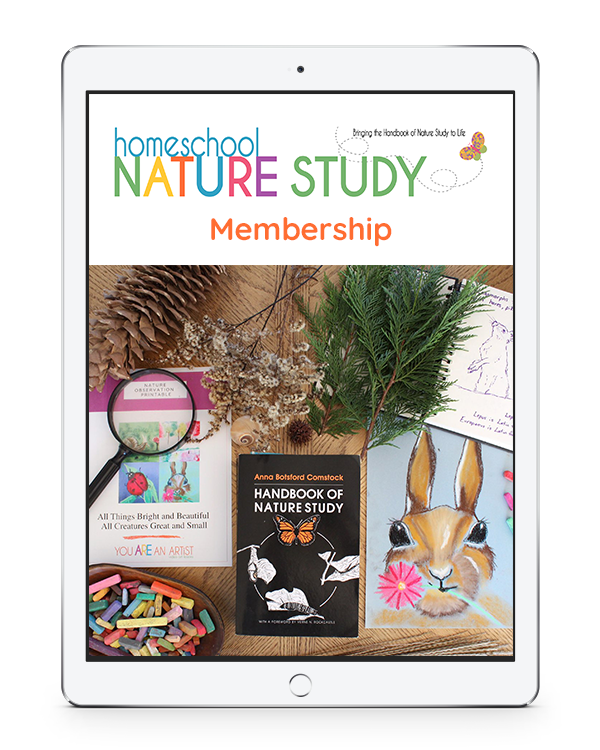
Amy: Okay. We’re not supposed to sit there with the book and read it from cover to cover with our children?
Shirley: No. It is not meant to be read from beginning to end. It’s a resource to dip into.
Tricia: I was going to say it absolutely scared me too when I first saw it. It is. It’s just a reference book and you can just take an opportunity. You don’t have to go back and refer to it every single time either. It’s just that, it’s there for you if you need it.
The Outdoor Hour Challenge
Amy: Maybe I have been using it correctly all these years. I thought I was wrong, but it’s okay. Well, how about this outdoor hour challenge? Is that what it’s called? How did that start? What exactly is an outdoor hour challenge?
Shirley: Tricia, do you want me to start with that?
Tricia: Well, I can tell the history of it. The outdoor hour challenges were started by Barbara McCoy. She is a veteran homeschool mom who has all graduated four children. She began those just out of the love of nature study in her own family, using the Charlotte Mason method. She began sharing that online on her blog. It just really started a revolution in families. It spoke to their hearts, just these simple how-tos, and let’s just focus on one little thing and go outside and see if we can find it. If we don’t find it, then we’ll be sure to find something else and just enjoy our time.
That is the outdoor hour challenge. Now the hour includes maybe some time for the mother to look at Handbook of Nature Study, about the topic, and then maybe spending 15 minutes, however long you really want to, outside. Then, if you want to, come inside and nature journal about what you saw and maybe draw a little diagram. It’s very, very simple, the outdoor hour challenge.
Amy: Does a mama come up with these ideas on her own, or do you guys direct like a particular challenge per week or month? How does that work? Shirley?
Shirley: We have planned out a full year’s curriculum of what we are going to focus on each week. Our members get that plan, that annual plan. They know well in advance, what they’re going to be covering. We then produce a weekly challenge, which is full of ideas on how you can teach this to your children, for our non-members, we have an amazing, just an absolute wealth of archived posts from Barb, who was the founder of the outdoor hour challenge, to give you ideas and to lead and guide you, on your time out nature.
Can I just say that hour, for us in our homeschool was always longer than an hour because it was just so joyful, it was so lovely. Don’t be limited, but it’s just to encourage you, like Tricia said without any pressure, very simply to get outdoors with your children once a week, at least
Amy: Takes it from being something overwhelming and too big like, where do I even start, to just a manageable, simple step.
Shirley: Exactly. I often think that, as moms, if something is really daunting to us, we tend not to do it. This way, you just get outdoors, and like Tricia said, if you don’t find whatever the topic is on the challenge, you will find something else just like you did when you were on a walk and a spider was spinning its webs. It doesn’t have to be that again, try not to be that box ticker, which I think most of us are.
If something else presents itself, go with that and enjoy that. Even if it’s just observational together, you will learn so much like you did watching a spider spin its web. You didn’t know what that looked like before, but after having that time, you did, so something else will present itself if you cannot find, especially, I know the handbook of nature study is an American, it was written by an American and it’s American flora and fauna and birds of nature, but it’s not limited to one country because we live in the UK and have found many of those things.
Maybe our robin looks different to your robin, but it’s still a robin, or your chickadee is different. We have a similar thing that is called a coal tit. You can find something similar where you are.
Amy: We don’t go out there and we’re like, no kids, you can’t watch that bird making a nest because that was not what was on our challenge for this week.
Shirley: No, absolutely not. In fact, I think Tricia, you would agree Barb would be horrified if you did that.
Tricia: Absolutely. Yes. We should mention that Barb retired and that is why we have stepped in to continue this. Shirley and I both have a huge passion for keeping her veteran voice out there because she spoke such life into each of our home schools. We wanted that to continue to be available to other families.
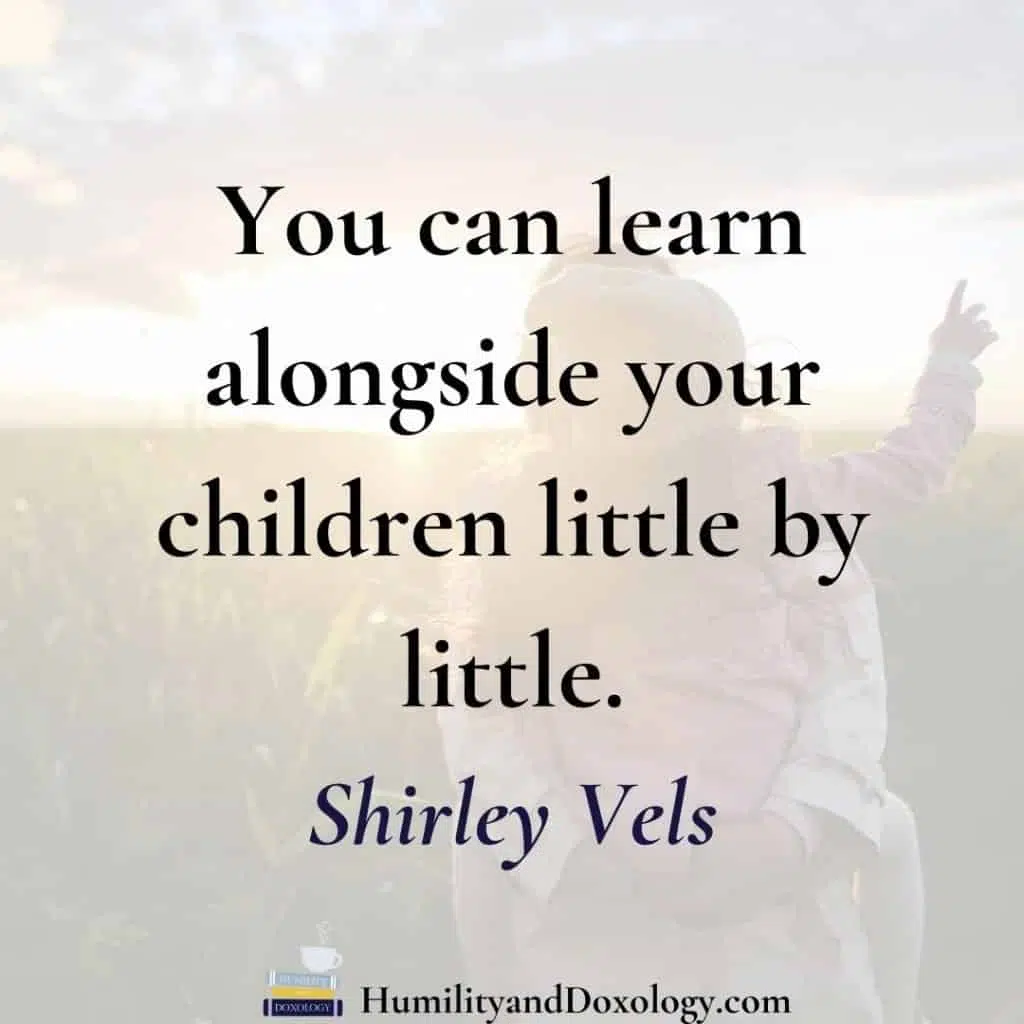
Are there any other benefits to nature study?
Amy: I feel like we’ve already touched on this a lot, but are there any other benefits of nature study? You feel like we haven’t mentioned that you want to make sure to get in here at the end, Tricia?
Tricia: I think we mentioned before that just by offering this, you don’t really know what it might lead to. Like it’s a different level of learning. If you were to stay in one area, you might not realize that your son really learns in a kinesthetic way and likes to have hands-on type experiences and that it opened up a whole new way of learning for him. I know also that Shirley has a story about her daughter.
Shirley: My eldest daughter, well we kept a nature journal, with our nature studies, and of course, they started off and our drawings with terrible, but that’s okay because it’s a skill that’s, it grows and you learn. Throughout the years, our observational skills got better and our drawing and painting skills got better. In the case of my oldest daughter, became a passion so much so that she chose to go and do illustration at university. Her goal is to be a botanical administrator and she’s really good.
That would not have happened. It absolutely would not have happened if we had not been diligent in doing our nature study and keeping a nature journal. You just don’t know how it’s going to touch your children and what influence it’ll have in their futures.
Amy: That is amazing, just that broadening of the horizons and how it helped your daughter see something that she might not have seen otherwise. That’s amazing.
The NEW Fine Arts Curriculum from the You ARE an Artist Program
I know along with the nature study things, you have a new line of fine arts curriculum that’s been added to the, You ARE an Artist Program. Tricia, can you talk a little bit about that, what’s involved there?
Tricia: Absolutely. This also goes back to crediting Barbara McCoy, who is the founder of this line of the curriculum. When she retired, we brought that in under the You ARE an Artist artist umbrella. It is yet another area of beauty that we discovered in our homeschool and just spending just a little bit of time once a week, studying famous artists, listening to wonderful, great composers, and how she did this was that she was spending all this time gathering all these online resources to do this study in her own home school. She just started gathering things together in ebook form and would put together graded level, fine arts studies.
That’s what we have pulled in under our umbrella. It is just like You ARE an Artist because it’s so easy, open, and go. It’s not a huge time investment. It just opens the door to yet another level of beautiful learning.
Amy: I love that. I think something that I try to emphasize a lot in that I’m very thankful the guests on this podcast all seem to agree on is that we can reject this all-or-nothing approach to homeschooling, which that perfectionist idolatry can be a real burden. We think, unless we’re doing something big and grand and glorious, it doesn’t count, but to just be reminded, as we’ve been reminded today, these little moments, these small choices that we prioritize and include, they add up over time.
It’s not just like the one day that you’ve spent 10 hours on something, it’s the few minutes here and there that are adding up over the whole course of your homeschool. That can be a real encouraging thing and take that burden off a homeschool mom, I think.
Tricia: Yes.

Tips for Helping the Homeschool Day Run Smoothly
Amy: Well, here at the end, I’m going to ask you the question I’ve been asking all of my guests this season, so I will start with you, Shirley. The first question is just, what are your best tips for helping the homeschool day run smoothly?
Shirley: I think for me, it’s a routine. I don’t mean that now you’ve gotta stick to this fixed routine because there is flexibility in that, but for me, I would always get up before my children and I would have my quiet time. If I did not start my day in the word of God, guaranteed, my day would just look awful. I think for mom, preparing her heart first and getting up before her children, I know that can be difficult when your children are very young and get up at four o’clock in the morning.
Generally, if you try and do that, and maintain that routine, we always had certain things that we would do, and although plans would not have always gone according to plan, we still had that very loose idea of what our day was going to look like. Try and keep in a routine, whatever that routine is that that is for you, whether it’s year-round homeschooling, or if you following terms, and stick to it, that’s the best advice I can give.
Amy: How about you Tricia?
Tricia: Along the lines of habits. One thing that really helped me, especially as my family grew, and I had this age range of children and I just was at a loss for how out to even get everything done that I wanted us to be able to do, one of my dear friends in my homeschooling group said, “Well, why don’t you just do one more thing after lunch?”
Just building that habit of one more thing actually made it something that we would look forward to. “What’s the one more thing we’re going to do after lunch? Is it going to be nature study? Is it going to be famous artists’ study or are we just going to do a little bit more of our history learning?” It was sort of a safe place to have that habit built-in. Even if the morning just went crazy, then we still had time to start over after lunch and get a little bit of learning in together.
Another thing that was along the same lines of that is we sometimes would just build in a whole day on a Friday just to do fun things, and to say, “Well, maybe we haven’t read all of our read-aloud yet but we just want to sit down and spend an entire day with it.” We would just allow ourselves that time on a Friday. That was one of those freedoms yet again.
Shirley: Can I add one more thing?
Amy: Definitely.
Shirley: On the subject of when your homeschool day goes a bit pear-shaped because we all have them. [laughs] When the children are just bickering and they’re just not concentrating, at that point, you have that freedom to change the whole day. I remember on a couple of occasions when we had a day like that, of just saying, “You know what? Close your books, put on your jackets, let’s go outside and go for a walk.”
We would go completely against the schedule on a walk, just with no agenda, down to the pond or whatever it was, and then come back, have a cup of tea. Amazingly, attitudes were brighter and you could pick up again. Don’t be afraid to, “It’s really not going well.” Close the books, have a complete change of scenery and then come back.
Amy: Probably good for mom’s attitude as well, right?
Shirley: Exactly, yes. [laughs]
What Tricia and Shirley are Reading Lately
Amy: The last question I’ve been asking everyone is, what are you personally reading lately? Tricia, do you have any books to recommend to us?
Tricia: I have been reading each morning a book by Paul David Tripp. It’s a devotional book called New Morning Mercies. I’ve just been enjoying that. It was recommended by a friend. Then, I also have a subscription to Homeschooling Today Magazine and the new Learning Well Journal. I have strategically placed those either in my on-the-go bag or just at the end of a coffee table so that I can pick it up and read one of those encouraging articles. I just seem to be in a moment of, “Let’s just do quick little reads here and there.” That’s what I’ve been setting up for myself.
Amy: I’d talked to Alicia earlier this podcast season about her new journal and I’m just so excited for this endeavor and how she’s encouraging the Homeschool community with it. It’s really cool. Shirley, how about you? What are you reading lately?
Shirley: I am reading a book called The Magic Apple Tree. There’s no magic involved. [laughs] It’s written by Susan Hill about her life in the Oxford countryside and it’s an observational book. It’s really just looking at the English festivals and traditions that we have here, village life, gardens, the rhythm of the years. It’s really lovely actually. I think it goes well really if you’ve got this heart for simplicity and the small beautiful things because that’s what she’s writing about. Just the everyday ordinary beautiful things. I’m enjoying that book at the moment.
Amy: Every time I asked this question, I always end up with more books on my to-be-read stack. It’s a dangerous question to include on my podcast. [laughs]
Shirley: Absolutely. I’m exactly the same. I have a reading list as long as my arm and I don’t think I’m ever going to get through all of them. Hopefully, I will, but I think as Homeschooling moms, we’re always going to have a running book list. Aren’t we?
Amy: Yes. It’s part of our job description, I believe. [laughs]
Shirley: Absolutely. [laughs]
Find Nature Study Homeschool Online
Amy: Where can folks find you both and Nature Study Homeschool all around the internet? Tricia, where can people find you?
Tricia: They can find us at youareanartist.com and then our sister website, naturestudyhomeschool.com.
Amy: Anywhere else we should follow you, Shirley?
Shirley: For my personal blog, it is buildingahouseholdoffaith.com but if you’d like to follow along on Outdoor Hour Challenge, we are on Instagram @outdoorhourchallenge, and we would absolutely love to have families tag us in your nature study pictures. We’d love to share and comment on them and just have you as part of the nature study community.
Amy: Wonderful. I will link up all those things in the show notes for this episode over at www.humilityanddoxology.com. Thank you both so much for taking the time to chat with me this morning. It’s been a lovely conversation.
Check out all the other interviews in my Homeschool Conversations series!
